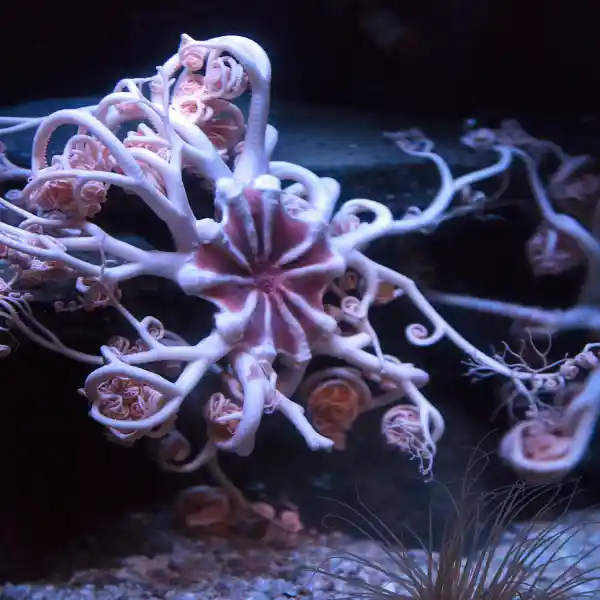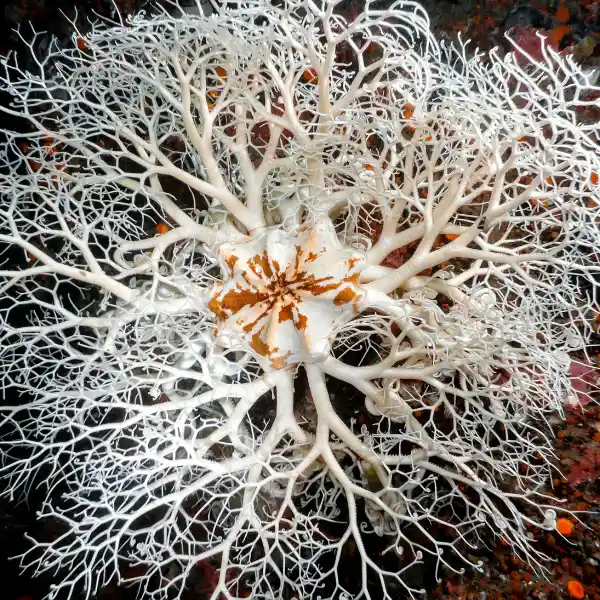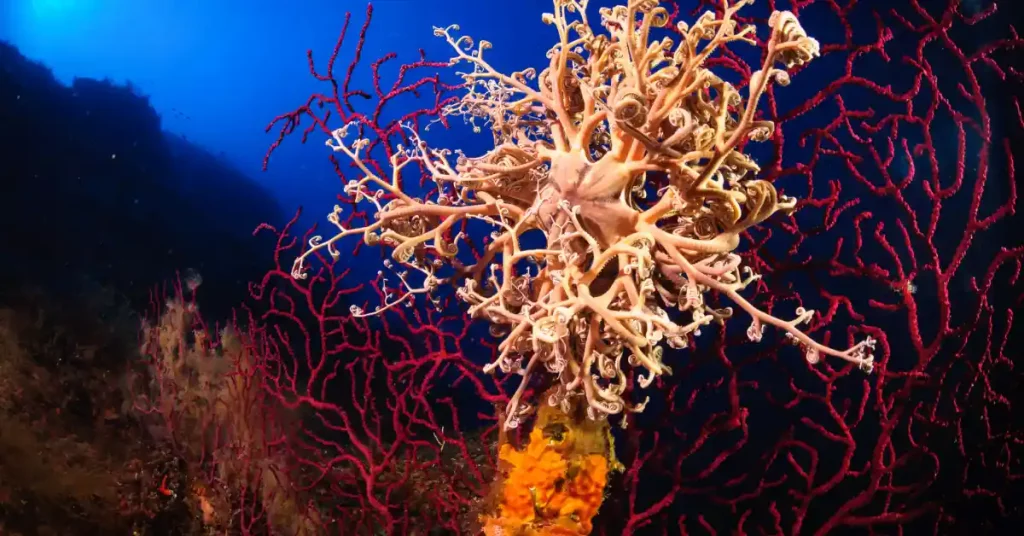Basket starfish are a type of brittle star, and they are sometimes referred to as basket-shaped brittle stars. The scientific name for the basket starfish is Euryalina. The basket starfish has many other common names, such as the snake star, common basket star, basket star, and brittlestar.
The basket starfish belongs to a group of animals called echinoderms. All echinoderms have five-fold symmetry and a skeleton that is usually made out of calcium carbonate plates that form hard skin.
The term “basket star” can refer to any species of starfish in the family Gorgonocephalidae. To date, there are more than 30 different known species of basket stars. There are other types of basket stars that have yet to be named.
Basket Starfish Appearance
Basket starfish are related to brittle stars and sea stars. They have radial symmetry, which means their body parts radiate from a central point. Their many arms, or rays, form a basket shape as they branch out from the central disk, giving them their common name. They range in color from red to green to purple.
The average size of the basket starfish is between 20 and 26 cm in diameter. Their disc is round, spiny, and deeply lobed. They can reach up to 70 cm in length and have hundreds of little branches on each arm. Each arm branches out into many smaller secondary branches. These secondary branches are covered with tiny spines that are used to help trap food particles. The color of this species varies from gray to red.
The arms of the basket starfish have smaller branches that look like fingers. These are connected by tiny webs, which makes them look like a spider’s web. This is why the basket starfish is also called the crab-like brittle starfish.
The body of the basket starfish does not have an obvious shape and is usually hidden in a nest formed by its arms. These arms are very long and highly branched. They are also covered with tiny hook-like spines that allow them to firmly attach themselves to rocks or coral.
Despite its name, the basket starfish is not really a ‘starfish’ at all! It is one of the thousands of echinoderm species—sea creatures that have a skeleton on the outside of their bodies.
Diet & Feeding behavior of Basket Sea Stars
Basket stars are carnivores and feed on zooplankton and other small animals in their environment. The basket star will sit in one place and wait for its prey to come to it. Once the prey is within reach, the basket star will wrap its branches around it and eat it. They eat mostly worms, mollusks, small crustaceans, and plankton.
The basket starfish is almost exclusively a nocturnal feeder. They will usually close their arms down at night and during the day to protect themselves from predators. These sea stars are carnivorous, feeding on zooplankton, small invertebrates, and organic material. Small particles are caught in the arms of the starfish and moved into its mouth by mucus that covers the entire surface of a basket star.
The basket star is an opportunistic feeder, meaning it will eat whatever prey it can find. If a basket star does not have enough food in one place, it can move to another location. This is one reason why there are so many of these sea stars all around the world.
The feeding behavior of basket stars is complex, with each branch having a different function in the process. The more highly branched secondary branches are responsible for catching prey, while the larger primary branches serve as collecting arms.
Basket stars use their interwoven arms to create a funnel-like trap that allows them to capture prey without expending much energy. As microscopic zooplankton approaching the basket star get caught in the branches, they are moved toward the mouth using smaller tentacles found along the length of each arm.
Basket Sea Stars-Natural habitat
Basket stars are marine invertebrates found in all the world’s oceans. They live on the seafloor and are typically located deep in the ocean. These animals have both an oral and an aboral surface, as well as bilateral symmetry.

The Basket Starfish is a species of starfish that can be found in the northern and southern hemispheres. The Basket Starfish ranges from the shallow waters of the Atlantic to depths of up to 9,400 feet. There are two different types of basket starfish; the northern basket star and the southern basket star. The main difference between the two species is that the Southern Basket Star has longer arms than its counterpart.
The range for the Northern Basket Star is from Massachusetts to Bermuda and down to Brazil, including the Gulf of Mexico. The southern range for this species includes Namibia, South Africa, Australia, and New Zealand.
The range of the Southern Basket Star stretches from Alaska to California and down to Panama, including the Gulf of California. Some species live at depths of up to 12,000 feet (3,600 meters), while others prefer shallower waters. Basket starfish inhabit a variety of sea habitats, including coral reefs.
Reproduction and Growth
Like other echinoderms, the basket starfish has bilateral symmetry. This means that it can be divided into two identical halves vertically through the center. Another unique characteristic of this species is its ability to regenerate or regrow its limbs when they have been lost or damaged.
Basket stars are “gonochoristic,” which means they have separate male and female sexes. During the winter months, basket stars shed their gametes (eggs or sperm cells) into the water. Fertilization of the eggs is external and occurs when the sperm cell of another basket star reaches an egg. The fertilized eggs hatch into planktonic larvae that drift with ocean currents for a few weeks before settling to the bottom of the sea.
The young basket stars spend their first few years as juveniles on the seafloor, eating small organisms. As they grow older, they develop long arms and begin to feed like adults by extending their arms upward toward moving currents of water.
The basket star reaches sexual maturity when it is about 10 cm in diameter. Basket stars can grow to 1.2 meters (47 inches) wide but typically grow to be 25-30 centimeters (10-12 inches) wide. They are able to achieve these sizes by having a highly branched arm with hundreds of tiny branchlets, which gives them the appearance of a basket. It is a simultaneous hermaphrodite, meaning each organism has both male and female reproductive organs. Spawning occurs at night and involves the discharge of gametes into the open water column.
Predators and Threats to basket sea stars
The basket star’s most common predators include sea otters, sea urchins, sea lions, large fish, sharks. and octopus. The octopus will use its arms to grab hold of the basket star and drown it in order to eat it.
The basket starfish has many natural predators. These include humans and larger sea creatures. Although the basket starfish cannot kill humans, it can cause an allergic reaction after it comes in contact with human skin.

One of the biggest threats to this species is climate change. The basket starfish has very specific environmental requirements, which means that any environmental changes could affect their survival. Climate change is a global problem and has affected species all over the world. They have many predators because their skin is soft, making them vulnerable to being eaten.
The way basket stars defend themselves from these predators is by moving away from them. Even if the predator catches them, they can remove their arms from their body and grow new ones. They also have a defense mechanism against other animals that try to attack them – when threatened, they release a sticky mucus that is toxic to other animals.
Cool facts about basket starfish
- Basket starfish are closely related to starfish, but have a few key differences which set them apart from their cousins.
- They are the largest of all brittle stars and can grow to around 90cm (35in) in length.
- In contrast to most other starfish species, they have five arms which branch into smaller segments. Unlike other starfish, basket stars do not have tube feet.
- Instead, they use their long arms as legs to move around slowly on surfaces such as coral reefs, where they live.
- They are also carnivorous animals and hunt small prey using their long arms, which end in numerous small filaments.
- Basket stars catch animal plankton by trapping it in the fine hairs on their arms before bringing it to their mouth for feeding.
- Long arms that branch and have skin resembling a basket. Arms are not spiny, but are covered in tiny hair-like structures. Branching arms are often coiled.
Basket Starfish-Related FAQs
Q1. Do basket starfish move fast or slow?
Sea starfish move slowly with their tube feet, but they can move very fast when needed. Starfish can swim by thrusting their arms upward. They also can detach their arms to escape predators. Regeneration is possible if the central disk is intact.
Q2. Are they dangerous to touch?
Basket starfish are generally harmless, but some species can be dangerous to humans. Basket starfish aren’t dangerous to humans, but you shouldn’t touch them since most species have sharp spines on their bodies. The basket starfish is not just a threat to humans, but also to animals as well. Some have been known to bite or scratch when threatened or attacked by another animal. This can result in serious injury or even death for an animal that does not have the natural defenses against an attack like this.
Q3. Does it need anything special in its tank?
The basket starfish is often kept as an aquarium pet. However, it must be provided with plenty of food and live rock. The live rock provides hiding places where the basket star can go when it feels threatened or when it wants to sleep. They are very hardy and can withstand poor water conditions, provided they get regular food. To keep them healthy, you should offer them a varied diet.
Q4. Is a basket star poisonous?
Basket stars are not poisonous, but they might be harmful to touch. Basket stars have tiny spines called pedicellariae that can pinch, giving you a good scare. These spines are often used as weapons by predators to protect themselves against them, but they are too small to damage human skin.
Conclusion
Basket starfish are very interesting and beautiful creatures. They are also quite unique, as they have a special way to capture and eat their food. The Basket Starfish is unique, and once cared for correctly and given the space it needs to thrive, there is no doubt your pet will appreciate being part of your family. The Basket Starfish is no ordinary starfish. You may have heard of Sea stars, but the Basket Starfish is a sure bet to win your heart.
